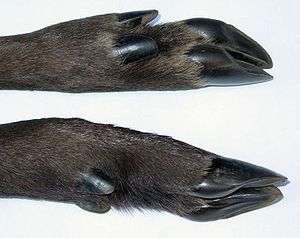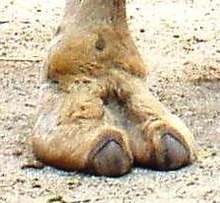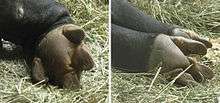Hoof

A hoof (/ˈhuːf/ or /ˈhʊf/), plural hooves (/ˈhuːvz/ or /ˈhʊvz/) or hoofs /ˈhʊfs/, is the tip of a toe of an ungulate mammal, strengthened by a thick, horny, keratin covering.[1]
Artiodactyls are even-toed ungulates, meaning that these species have an even number of digits on each foot. Ruminants, with two main digits, are the largest group. Examples include deer, bison, cattle, goats and sheep.[2] Perissodactyls have an odd number of toes. Examples of perissodactyl mammals are horses, rhinoceroses and tapirs.[3]
Hooves are generally cited as limb structures restricted to placental mammals, which unlike other mammal groups undergo prolonged pregnancies. However, the marsupial Chaeropus had hooves.[4]
Description

Pink: soft tissues;
light gray: bone;
blue: tendons;
red: corium;
yellow: digital cushion;
dark gray: frog;
orange: sole;
brown: walls
The hoof surrounds the distal end of the second phalanx, the distal phalanx, and the navicular bone.[5] The hoof consists of the hoof wall, the bars of the hoof, the sole and frog and soft tissue shock absorption structures.[5] The weight of the animal is normally borne by both the sole and the edge of the hoof wall. Hooves perform many functions, including supporting the weight of the animal, dissipating the energy impact as the hooves strike the ground or surface, protecting the tissues and bone within the hoof capsule, and providing traction for the animal. Numerous factors can affect hoof structure and health, including genetics, hoof conformation, environmental influences, and athletic performance of the animal. The ideal hoof has a parallel hoof-pastern axis, a thick hoof wall, adequate sole depth, a solid heel base and growth rings of equal size under the coronary band.[6]
There are four layers within the exterior wall of the hoof. From the outside, a hoof is made up of the stratum externum, the stratum medium, the stratum internum and the dermis parietis. The stratum externum and the stratum medium are difficult to distinguish, the stratum externum is thin and the stratum medium is what makes up the bulk of the hoof wall.[7] Inside the hoof wall is a laminar junction, a soft tissue structure that allows the hoof to withstand the demands of force transmission it undergoes.[8] This tissue structure binds the inner surface of the hoof wall, the dermis parietis and the outer surface of the third phalanx.[8]
Most even-toed ungulates (such as sheep, goats, deer, cattle, bison and pigs) have two main hooves on each foot, together called a cloven hoof.[Note 1] Most of these cloven-hooved animals also have two smaller hooves called dewclaws a little further up the leg – these are not normally used for walking, but in some species with larger dewclaws (such as deer and pigs) they may touch the ground when running or jumping, or if the ground is soft. In the mountain goat, the dewclaw serves to provide extra traction when descending rocky slopes as well as additional drag on loose or slippery surfaces made of ice, dirt, or snow.[9] Other cloven-hooved animals (such as giraffes and pronghorns) have no dewclaws.
In some so-called "cloven-hooved" animals, such as camels, the "hoof" is not properly a hoof – it is not a hard or rubbery sole with a hard wall formed by a thick nail – instead it is a soft toe with little more than a nail merely having an appearance of a hoof.
Some odd-toed ungulates (equids) have one hoof on each foot; others have (or had) three distinct hooved or heavily nailed toes, or one hoof and two dewclaws. The tapir is a special case, having three toes on each hind foot and four toes on each front foot.
Management
Hooves grow continuously. In nature, wild animals are capable of wearing down the hoof as it continuously grows, but domesticated species often must undergo specific hoof care for a healthy, functional hoof. Proper care improves biomechanical efficiency and prevents lameness.[6] If not worn down by use, such as in the dairy or equine industries, hooves may need to be trimmed by a farrier. Appropriate hoof trimming is essential to prevent lameness. Within the equine world, the expression, "no foot, no horse" emphasizes the importance of hoof health.[10] Lameness, behind infertility and mastitis, is the biggest cause of economic loss to a dairy farmer.[11]
Hoof care is most well known with the equine industry.[6] Problems that can arise with poor horse hoof care include hoof cracks, thrush, abscesses and laminitis.[12]
 Rear foot of a giraffe (no dewclaws)
Rear foot of a giraffe (no dewclaws) Rear hooves of a horse
Rear hooves of a horse Camel hoof
Camel hoof Malayan tapir hooves: front with four toes, back with three toes
Malayan tapir hooves: front with four toes, back with three toes
In culture
Hooves have historical significance in ceremonies and games. They have been used in burial ceremonies.[13]
See also
Notes
- ↑ The term "cloven hoof" therefore being a technical misnomer as nothing is actually "cloven".
References
| Wikimedia Commons has media related to Hooves. |
- ↑ "the definition of hoof". Dictionary.com. Retrieved 2016-11-30.
- ↑ Keller, Anna; Clauss, Marcus; Muggli, Evelyne; Nuss, Karl (2009-07-15). "Even-toed but uneven in length: the digits of artiodactyls". Zoology. 112 (4): 270–278. doi:10.1016/j.zool.2008.11.001.
- ↑ Holbrook, Luke T. (1999-09-01). "The Phylogeny and Classification of Tapiromorph Perissodactyls (Mammalia)". Cladistics. 15 (3): 331–350. doi:10.1111/j.1096-0031.1999.tb00270.x. ISSN 1096-0031.
- ↑ Sánchez-Villagra, Marcelo R. (22 December 2012). "Why are There Fewer Marsupials than Placentals? On the Relevance of Geography and Physiology to Evolutionary Patterns of Mammalian Diversity and Disparity". Journal of Mammalian Evolution. 20 (4): 279–290. doi:10.1007/s10914-012-9220-3.
- 1 2 "Basic Farriery for the Performance Horse". Veterinary Clinics of North America: Equine Practice. 24: 203–218. doi:10.1016/j.cveq.2007.12.002. Retrieved 2016-11-30.
- 1 2 3 "Basic Farriery for the Performance Horse". Veterinary Clinics of North America: Equine Practice. 24: 203–218. doi:10.1016/j.cveq.2007.12.002. Retrieved 2016-11-30.
- ↑ Goulet, Catherine; Olive, Julien; Rossier, Yves; Beauchamp, Guy (2015-11-01). "RADIOGRAPHIC AND ANATOMIC CHARACTERISTICS OF DORSAL HOOF WALL LAYERS IN NONlAMINITIC HORSES". Veterinary Radiology & Ultrasound. 56 (6): 589–594. doi:10.1111/vru.12280. ISSN 1740-8261.
- 1 2 "Shape, Orientation and Spacing of the Primary Epidermal Laminae in the Hooves of Neonatal and Adult Horses (Equus caballus)". www.karger.com. Retrieved 2016-12-16.
- ↑ A Beast the Color of Winter: The Mountain Goat Observed. U of Nebraska Press. 1 February 2002. p. 52. ISBN 0-8032-6421-6.
- ↑ Aoki, Yasuhiro (2006). "Changes in walking parameters of milking cows after hoof trimming|(Aoki, Y. et al., 2006)". Animal Science Journal. 77: 103–109. doi:10.1111/j.1740-0929.2006.00326.x – via Wiley Online Library.
Lameness, behind infertility and mastitis, is the biggest cause of economic loss to a dairy farmer (Weaver, A., 2006). Many farmers and veterinarians have used a phase that distinguished that if the animal has bad hooves then it is of no use, the most common version of this phrase is used with equine, "No hoof no horse."
- ↑ Weaver, A. D. (1985-01-01). "Lameness in cattle—Investigational and diagnostic check lists". British Veterinary Journal. 141 (1): 27–33. doi:10.1016/0007-1935(85)90123-X.
- ↑ "Common hoof problems : Horse : University of Minnesota Extension". www.extension.umn.edu. Retrieved 2016-11-30.
- ↑ M. E. Robertson-Mackay (1980). "A head and hooves burial beneath a round barrow, with other Neolithic and Bronze Age sites on Hemp Knoll, near Avebury, Wiltshire". Proceedings of the Prehistoric Society.